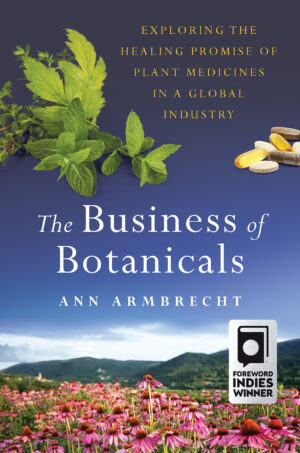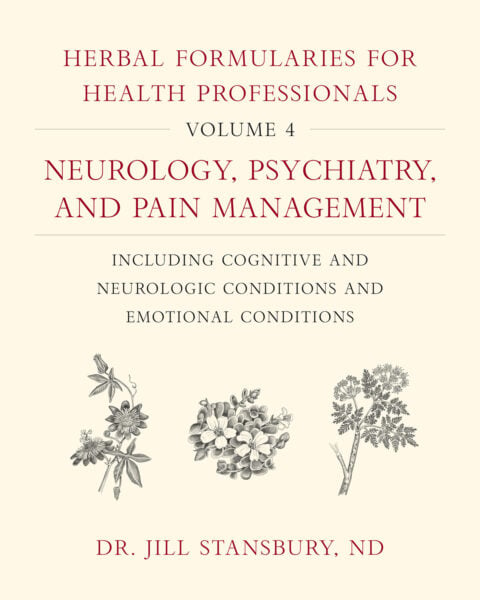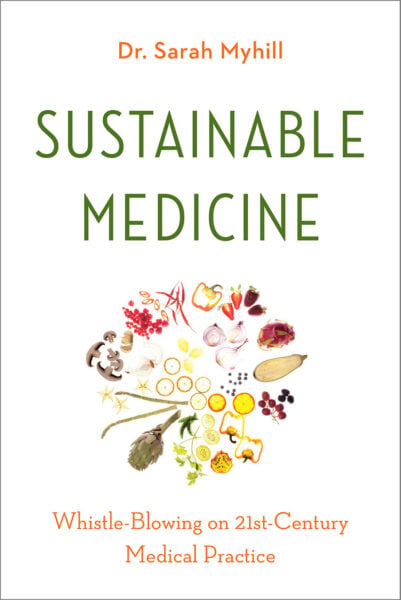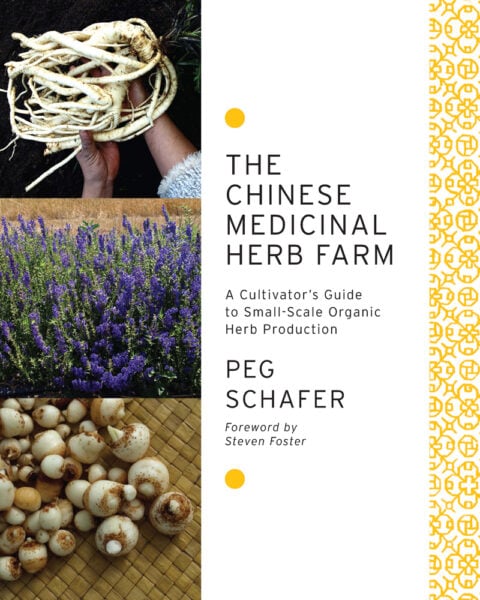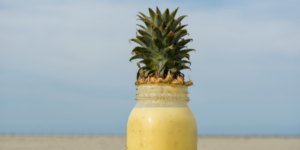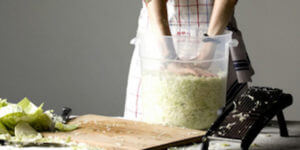Medicine as a Process, Not a Product
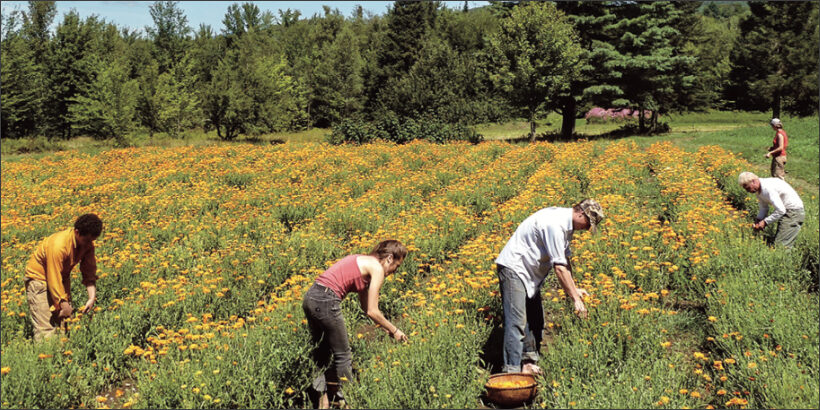
What do you picture when you think of medicine? Pharmacy shelves filled with plastic bottles promising cures to your every ailment? A doctor’s office? Whatever you think of, you probably don’t picture fields of medicinal herbs or bookshelves covered in jars of amber-colored liquid or trained hands drying leaves and cutting roots. What if, at its core, medicine is not about the product, but about the process.
The following excerpt is from The Business of Botanicals by Ann Armbrecht. It has been adapted for the web.
(Organic calendula fields at Zack Woods Herb Farm, Vermont. Photo courtesy of Jeff and Melanie Carpenter.)
I first recognized medicine as a process rather than a product at a tincture-making workshop in the mid-1990s. The young teacher showed us a twisted echinacea root she had dug from her garden the previous day. “It’s easy to wash the roots,” she said. “Just use a strong hose.” She demonstrated how to break the root into smaller pieces to remove dirt from the crevices. “Cut up the root as small as possible,” she added as she chopped it into tiny pieces. She explained that the greater the surface area that comes into contact with the menstruum— the solvent used to extract compounds or constituents from the plant material—the more constituents would be extracted. She dumped the root bits into a mason jar, covered the roots with vodka, put a lid on the jar, and shook. Let it sit in a dark place for six weeks, she said, then strain off the liquid, which is the medicine. The leftover bits of root, called the marc, can be composted.
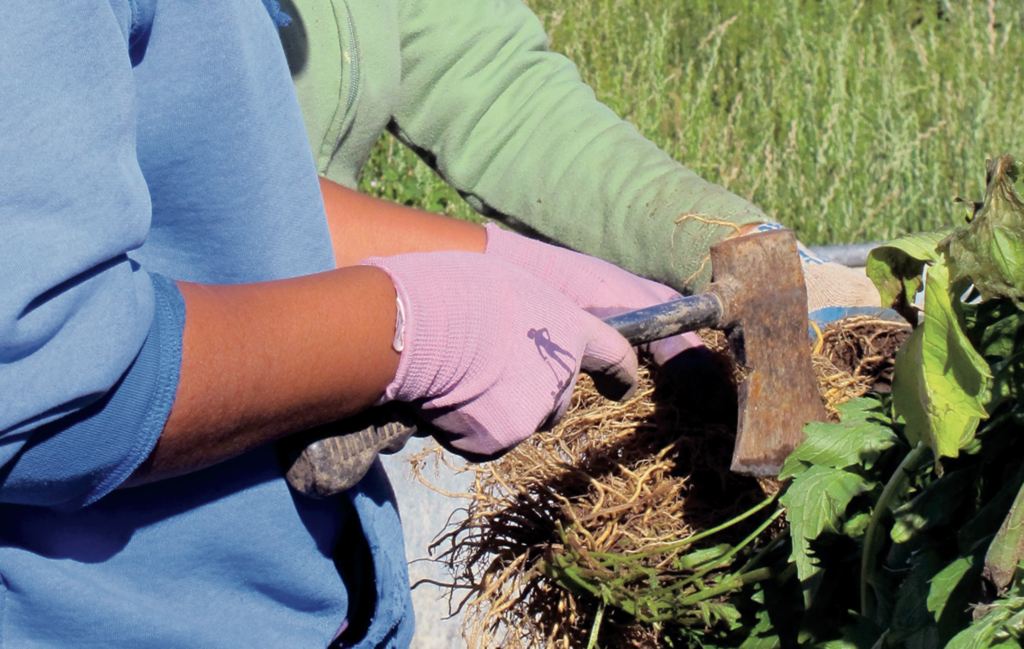
Chopping freshly harvested valerian root before washing and processing at Oregon’s Wild Harvest, Sandy, Oregon.
The demonstration lasted only ten minutes. For the remainder of the hour-long class, the instructor talked about the uses of various medicinal plants. I only half listened. I was still marveling at the simplicity of the medicine making. It would be one thing if making a tincture was difficult or time consuming, but it isn’t. The process is a bit messy, but it is easier than making a cake, even a cake from a packaged mix. And yet I had never before considered the possibility that I could make my own medicine. To me, medicine was what I bought at a pharmacy, what a doctor would prescribe for me, not something concocted with roots and leaves and some vodka in my kitchen. Why hadn’t anyone ever told me how easy this was? Or that I could do it myself? In my own home? With the root of a plant I could grow in my own garden? And that it was so inexpensive? I was preoccupied by the cost and by another more confounding question, which I had never considered before. When— and how—had medicine become a product to buy instead of a skill we could share?
Restoring Balance
The following year I met Deb Soule at a retreat to envision an organization that would honor of the work of simple-living advocates Helen and Scott Nearing. Deb ran a small apothecary selling remedies prepared from herbs grown in her biodynamic gardens in Downeast Maine. She brewed pots of tea from loose dried flowers and leaves. I was used to my coffee strong and my tea in bags, and so I was curious. It tasted a bit like grass. Deb talked about her gardens and the medicines she made in her kitchen and the community clinic where she met with clients. It all sounded small-scale and right-sized. She mentioned that she was buying some land up the road from her house to expand her gardens and that I should come visit.
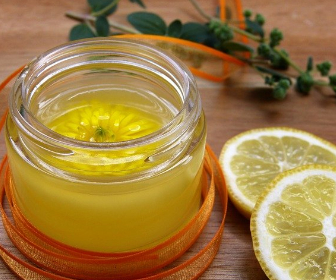 Later that summer I did visit. Deb and I gathered nasturtiums and greens from her garden for dinner. In her house, jars filled every open surface: counters, wooden shelves, tables by a futon couch. Some jars were filled with dried orange flowers or green leaves, others with what looked like chopped roots soaking in a brown slurry. Still others held a deep golden or crimson oil. A sticky note on the oven door proved to be a reminder to check inside before turning the oven on, because there might be medicinal oils within, being slowly warmed by the pilot light. Deb’s house smelled earthy and slightly sweet, a greenish smell that is hard to describe but which I recognized immediately in every herb warehouse I subsequently visited on my travels for the Sustainable Herbs Program.
Later that summer I did visit. Deb and I gathered nasturtiums and greens from her garden for dinner. In her house, jars filled every open surface: counters, wooden shelves, tables by a futon couch. Some jars were filled with dried orange flowers or green leaves, others with what looked like chopped roots soaking in a brown slurry. Still others held a deep golden or crimson oil. A sticky note on the oven door proved to be a reminder to check inside before turning the oven on, because there might be medicinal oils within, being slowly warmed by the pilot light. Deb’s house smelled earthy and slightly sweet, a greenish smell that is hard to describe but which I recognized immediately in every herb warehouse I subsequently visited on my travels for the Sustainable Herbs Program.
When I was growing up, I never would have found medicinal oil in the oven in our family’s kitchen. More likely it would have been Hamburger Helper or minute steaks on the stovetop. The salads of my childhood were a chunk of iceberg lettuce with a dollop of bright orange French dressing from a bottle. Nestlé’s chocolate chip cookies were as homemade as we got. This wasn’t because my mother was negligent or didn’t care. This was the 1960s in West Virginia. The promise of the modern era was for women to spend less, not more, time in the kitchen, and I was born into a social class where that shift was possible. What mattered about food was that it was convenient and quick, not where the ingredients came from or how they had been processed. I grew up thinking of my body as something to exercise and to fuel as needed, like a car. I depended on my body, but didn’t think much about how it worked. When I was a college student at Dartmouth, a tree or a plant was what I passed as I hiked—or better yet, ran—up the trail to reach the top of the mountain.
Deb went on walks, not runs. She drank teas that nourished her body, not ones that kept her awake. She ate the foods she could grow in her garden, and whole grains she could grind herself.
Being with Deb, I was reminded of what I’d experienced in Nepal— in the way she talked, in the little things she noticed, in the pace at which she worked. She didn’t let the hurry around her change her rhythm. Her hands, like the hands of the women in Hedangna, were rough from a lifetime of working the soil. And she talked about plants as if they were alive—as if they were people with whom she could have a relationship, with whom she did have a relationship.
Recommended Reads
Recent Articles
Garlic mustard: while known as “invasive,” this plant can be consumed in its entirety and has great nutritional value. Plus, the garlic-flavor is a perfect addition to any recipe that calls for mustard! The following are excerpts from Beyond the War on Invasive Species by Tao Orion and The Wild Wisdom of Weeds by Katrina…
Read MoreMany know the effects of catnip on our feline friends, but few realize that catnip has medicinal effects for humans. From stomach aches to reducing fevers, catnip is a versatile herb with many benefits. The next time you grow this plant for your cat you may end up taking a few cuttings for yourself! The…
Read MoreWhether you’re looking to replace your end-of-the-day cocktail, relax before bed, or want something new to add to your tea, this non-alcoholic mocktail syrup base will do the trick. Delicious and all-natural, take a sip of this nightcap mocktail and feel your troubles melt away. The following is an excerpt from Herbal Formularies for Health…
Read MoreSurprisingly, medicine can actually be delicious. This anti-inflammatory smoothie uses natural (and tasty!) ingredients to help reduce inflammation caused by any number of circumstances. The following is an excerpt from Herbal Formularies for Health Professionals, Volume 4 by Jill Stansbury. It has been adapted for the web. RECIPE: Ginger and Pineapple Anti-Inflammatory Smoothie This is an all-purpose…
Read MoreMake your own delicious, healthy, probiotic sauerkraut! Four easy steps are all you need to turn fresh garden veggies into a long-lasting, tangy, pungent condiment. The following excerpt is from The Art of Fermentation by Sandor Ellix Katz. It has been adapted for the web. 4 Simple Steps to Making Sauerkraut The English language does…
Read More

